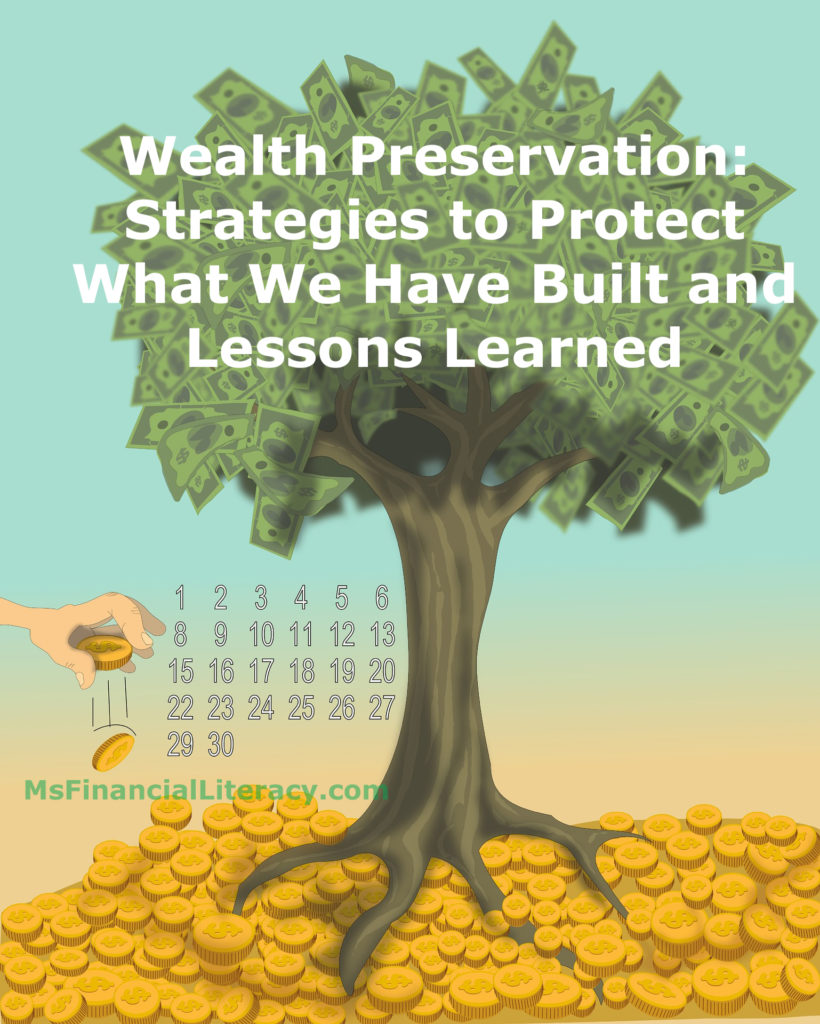In general, there are four phases to wealth management: accumulation, preservation (protection), distribution and transfer. My husband and I manage our own assets. In this post, I am using our story as an example illustrating why wealth preservation strategies are important for managing an investment portfolio and should be an integral part of financial planning. This is true when one is building wealth (wealth accumulation) and when one is approaching or in retirement (wealth preservation). Based on my research, many financial firms treat the four phases of wealth management as distinct financial steps when delivering financial guidance to clients. However, this approach is limited in scope. A financial plan is not well-thought out when an investor just focuses on the growth and yield components of a portfolio. As we accumulate wealth, we also need to implement financial strategies that safeguard what we have built and cushion the downside should the stock market become volatile.
Chasing Growth (Capital Appreciation) and Cash Flow (High Yields)
Throughout year 2009, all my equity holdings were either in individual stocks or index funds (it took another year before I learned about bonds). My investment goal back then was to see my capital grow as far as it could stretch. I also chased high yields (in the forms of dividends and interest payments), too. However, despite the hot chase, all those investments were done with much caution and education. Still, growth and cash flow were mostly what I focused my investment attention on.
Protecting What We Have Built
Then, my husband’s and my finances combined when we got married in the summer of 2010. As we continued tracking our net worth, each year I noticed a healthy and steady climb in our total number (you can read more about our financial numbers in this post). And at one point the number started getting so big that I had a hard time visualizing that quantity of money. It was around then (end of year 2010) that I started having regular discussions with my husband regarding protecting our wealth. As already mentioned in this post, we were saving aggressively for years, and I wanted us to do everything we could and knew of to protect what we have built.
In that process, we were learning and implementing investment strategies that minimize risks while still allowing our assets to grow steadily. As my husband and I have came to realize over the past five years, knowing about the strategies is one thing, but actually learning and incorporating them as part of our financial planning have been a whole level of challenge for us. A lot of considerations were involved. Each time we rebalance our portfolio it’s a balance act between risks, growth, cash flow and avoiding large irrecoverable losses.

Wealth Preservation Strategies
Diversify, Outpace inflation and Dampen Risks
As mentioned earlier, all through 2009 and 2010 our portfolio was invested in 100% equities. Having such a portfolio was great because historically stocks deliver the best returns over the long term (both through capital appreciation and yields). While implementing this strategy our portfolio’s performance certainly outpaced inflation. However, with a portfolio in 100% equities we also exposed our nest egg to more risks (read about asset allocation). Knowing what our risk tolerance levels are and being aware of the inevitable periodic swings of the stock market, my husband and I decided to reallocate our investment portfolio.
The first step we took was looking into bonds. It’s been commonly researched by economists and financial analysts that stocks and bonds tend to have inverse correlations. That is, when stocks (as a whole asset class) go up, bonds generally go down, and vice versa. What did it mean for our portfolio? If a time does come when stock prices are dropping steeply, it is our hope that our portfolio won’t be as greatly affected. By default, the bonds in our portfolio should shield us from some of that downside turn impacts.
Our earlier bond purchases included municipal bonds (mostly tax exempt) and international bonds (within our 401Ks). Some of those bonds had short maturities (offered lower yield) and others have long maturities (offered higher yield). Over time, we purchased more and more municipal bonds as they were especially attractive to us for tax reasons. Once we started acquiring more bonds, it also meant we were missing out on buying more stocks (which could have the potential to grow our capital and cash flow, too). In order to design a portfolio that outpaces inflation and also generates a healthier cash flow, we purchased some corporate and junk bonds, after having spent months studying them. Corporate and junk bonds usually yield higher interests for investors as they generally have less creditworthiness than municipal bonds.
All in all, our strategy here was to balance our portfolio with a mix of stocks (both individual stocks and index funds) and bonds. And within these two asset classes we had a mix of high and low yield holdings. This past weekend my husband looked at our portfolio and determined that roughly 35% of our holdings are in various types of bonds.
Seeking Smooth and Steady Returns
In addition to what was aforementioned above, we also purchased more equities (mostly large market cap individual stocks) that generally offered larger and more stable dividend payments. The great thing about dividend yields is that those payments can serve as cushions shielding our investments from market drops. According to the research my husband and I did, those companies were likely to grow their dividends over the long run, too. And because we diligently did our research, we hoped the stock prices will grow over time! However, we’re fully aware that these stocks by nature won’t offer us much capital appreciation. Unlike small cap stocks, large cap companies’ financial numbers and operations tended to be more stable and when prices do move the swings would be relatively small. As such, we won’t be seeing as many periodic large swings in our total number. We don’t even like it regardless the swing is up or down. After the Great Recession and the more I learned about and observed the stock market, my husband and I came to appreciate seeing smooth and steady returns in our investments. Over the years, we have grown our nest egg to a good size and it’s very precious to us. And for some time now, we haven’t felt a need to take high levels of risk with what we have accumulated.
Avoiding Large Irrecoverable Losses
Another strategy we share with other investors is this: be a proactive investor. Our portfolios are our hard earned money and it’s in our own best interests that we pay attention to what’s going on in the global economy. Nowadays, in the personal finance media there’s this popular saying that investors shouldn’t pay much attention or be affected by news headlines. To some degrees, that’s true. I don’t think it’s wise to react and rearrange our financial plans every time there’s a big news headline. However, paying attention to the general economic trends can be good when researching for future asset purchases or when looking to rebalance your portfolio. We don’t always have to respond to those events, but at least we know what’s going on and we can plan accordingly.
There were few times when my husband and I ignored the trending headlines and our portfolio suffered. With one stock in particular, as the price was dropping I thought the volatility was just coming from the periodic volatility of that particular asset market. However, little did I know, the price continued to drop and dropped sharply over a short period of time. If I had been more proactive at the time, I might have been able to sell at a time when the price dropped near my average cost. For now, I have to live with the loss. I generally had good feelings about this stock, and failed to see its risks in time. The company wasn’t involved in the oil business at the time I purchased all my shares, then over time it acquired some oil businesses (headline news were all over the media for weeks). By the time I realized how bad the oil industry has been doing, the price had already plummeted.
That was a very painful way to learn a lesson. The current share price is 71% below my average cost. As the investment is inside my Roth IRA I would not be able to claim capital loss (I will cover asset location strategies in a future post). Fortunately, I’m in a financial position where I don’t have to sell low and just ride the wave hoping to see subsequent rebounds (I need a 345% gain just to get back to even though).
(My husband and I own individual stocks. This is the reason why we need to be proactive with some of our investments. Many other investors invest a large percentage of their equities in index funds to avoid such potential large losses. And those investors need to be proactively rebalancing between indexes of different asset classes. I will talk about index funds in a future post.)
Concluding Remarks
In this post, using our own examples I discussed why wealth preservation is an important financial investment strategy and why it should be an integral part of financial planning. I also shared why it’s important to incorporate these strategies both during the wealth accumulation and wealth preservation phases. As investors, one of our biggest goals should to safeguard the wealth we have built. We won’t be able to keep our nest egg healthy if we are only myopically focused on chasing capital appreciations and high yields. Certainly, those are have a place in our financial planning. We just have to find a balance somewhere by using a mix of investment strategies that allow us to get closer to reaching our financial goals over time.
Your Turn!
Readers, do you incorporate wealth protection strategies in your financial planning? If so, which strategies you use?
What are some investment moves you have taken and vowed never to repeat?
What was going on at the time and what have you learned that you would like to share with others?
